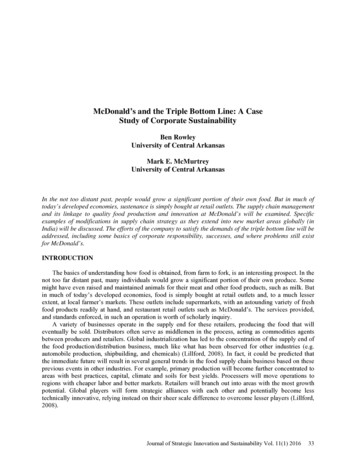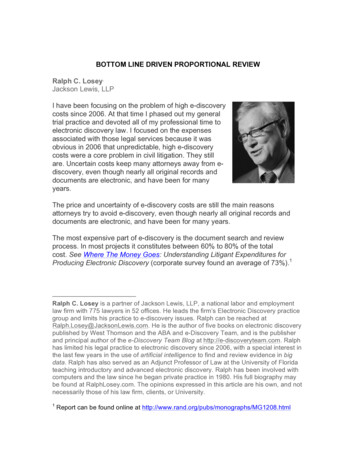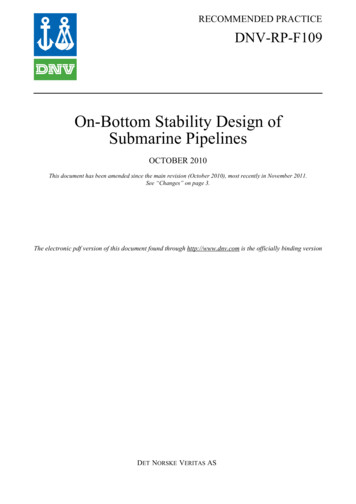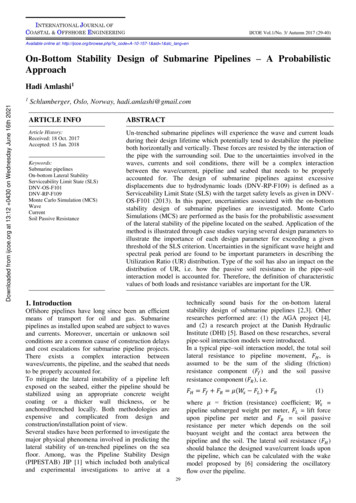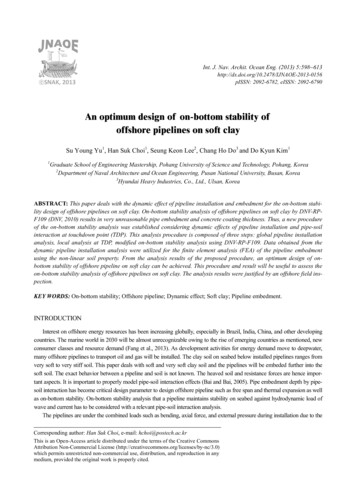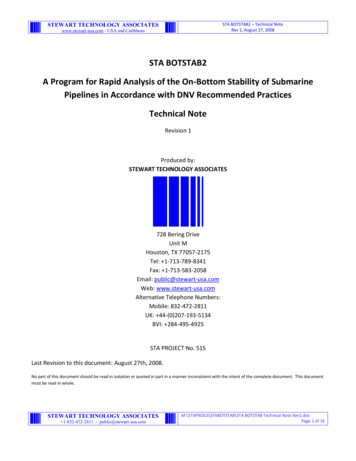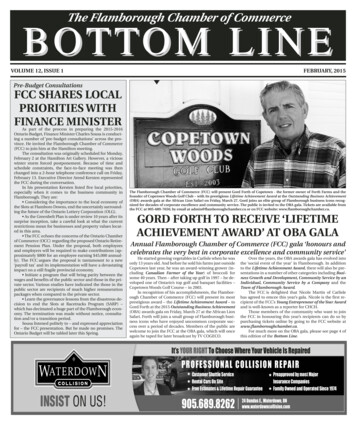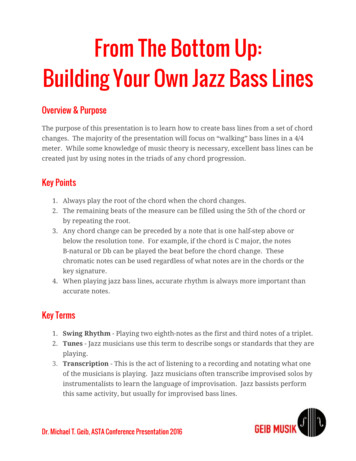
Transcription
From The Bottom Up:Building Your Own Jazz Bass LinesOverview & PurposeThe purpose of this presentation is to learn how to create bass lines from a set of chordchanges. The majority of the presentation will focus on “walking” bass lines in a 4/4meter. While some knowledge of music theory is necessary, excellent bass lines can becreated just by using notes in the triads of any chord progression.Key Points1. Always play the root of the chord when the chord changes.2. The remaining beats of the measure can be filled using the 5th of the chord orby repeating the root.3. Any chord change can be preceded by a note that is one half-step above orbelow the resolution tone. For example, if the chord is C major, the notesB-natural or Db can be played the beat before the chord change. Thesechromatic notes can be used regardless of what notes are in the chords or thekey signature.4. When playing jazz bass lines, accurate rhythm is always more important thanaccurate notes.Key Terms1. Swing Rhythm - Playing two eighth-notes as the first and third notes of a triplet.2. Tunes - Jazz musicians use this term to describe songs or standards that they areplaying.3. Transcription - This is the act of listening to a recording and notating what oneof the musicians is playing. Jazz musicians often transcribe improvised solos byinstrumentalists to learn the language of improvisation. Jazz bassists performthis same activity, but usually for improvised bass lines.Dr. Michael T. Geib, ASTA Conference Presentation 2016
Building Bass LinesBefore learning to build bass lines, the student must learn chord symbols and what they mean.The following are the most common chord symbols seen in lead sheets:? 4 www4C? wwwCsusw? b wwwwCmin 69? b wwwwC7? b b wwwwC7 b5b wwwCo or Cdimb b wwwC or Caugwwwwb wwwwwwwwwCmin or C-# wwwCCmin6C6wwwwCmaj7 or C b wwwwCmin7( b5) or CØ7bwb wwwb b b wwwwCmin7 or C-7b b wwww# b wwwwCo7 or Cdim7C7susCma7 #5# wwww69C7#5 or C 7Nwb wwwCmin (maj7)
Building Bass Lines2In addition, chords can also have added extenions of 9ths, 11ths, and 13ths.Major ChordsCmaj13( #11)w# wwwwww# wwwwwwCmaj9( #11)w? wwwwCmaj9Minor ChordsN wwb wwb wwwwb wwwb www? b b wwwwCmin13Cmin11Cmin9Dominant Chords*In major and dominant chords the11th is almost always a #11. It is alsosometimes implied and not explicitlyC13 written# wwwb wwwwC9( #11)#wb wwwwwC9w? b wwwwChords with extensions can also be altered, speifically by using b5, #5, b9 and #9.Below are some common examplesb wwb? wwwC7 ( b9)Cmin9 ( b5)w? b b b wwwwb b b wwwwwC7 b5( b9)# wwwb b wwwwC13 ( b5)C7( #9)b # wwwwwCmaj9 #11 ( #5)# ww# wwwwC7 #5( #9)b # # wwwwwC9 #11( #5)#wb # wwwwwKeep in mind that despite what extensions are added, the foundation of the chord (root, 5th, 3rd, and 7th)remains the same.
Building Bass Lines3Once the student has an understanding of chord theory, he or she can begin to create bass lines.The first lesson will be building walking bass lines in the 4/4 - meter swing style. In general, itis a good strategy to play the root of the chord on the downbeat of the measure. For example:B b7? bb œŒŒŒE b7bœŒŒŒœB b7ŒŒŒbœŒŒŒThe remaining three beats can be filled in by either repeating the root or playing the 5th of the chord.Also, the root can be displaced by octaves.B b7? bb œœœœE b7bœœœœœB b7œœœbœœœWhen students feel comfortable with the above concepts, they can create more harmonic interest in theirbass lines using the following methods: scalar, arpeggiation, and chromatic leading tones.ScalarB b7? bb œœœœE b7bœ bœœœœB b7œœœœœœ bœbœœœœœœœœœœArpeggiationB b7? bb œœœœE b7bœœœ bœœB b7ChromaticB b7? bb œœœ nœE b7bœœ bœ nœœB b7œœ nœB b7bœœWhen using chromaticism, it is important to remember that any note that is either a half-step above or belowthe resolution note can be used before a chord change. For example, if the resolution note is a C, then the bassistcan preceed that note with either a B-natural or D-flat, regardless of the harmonic construction of the chord.
Building Bass Lines4Once these methods have been learned, the student can combine all of them to create a walking bass line.Below is an example using all of the previously discussed concepts in a Bb blues progression:B b7? bb œœ nœœE b7? b bœbCmi7? b œbB b7? bb bœ? bbœE b7Cmi7? b œbE b7bœœ nœœ bœ nœœœœnœœ nœœ bœ nœœœ bœ nœœœ bœ nœF7œœ nœœE b7œœbœ bœF7œœœ nœœ nœœœœB b7B b7œœœ nœœœ bœœG7Cmi7B b7bœ bœB b7bœœB b7œbœB b7œ#œœbœbœnœœœ bœœœ #œG7œ nœœ nœG7œ bœG7œœF7œ nœœ bœ nœœœœ nœœœœCmi7F7œ
Building Bass Lines5It is common practice by jazz bassists to simplify a walking bass line by playing only on beats one andthree, usually during the beginning of the tune when the melody is being played. This simplificationis known as a Two-Beat Bassline. This style heavily utilizes the roots and 5ths of chords.B b7? bb E b7 b B b7 b Two-beat bass lines can be embellished by adding other notes, but it is imperative that the emphasisremain on beats one and three at all times.B b7? bb E b7œ nœb œœB b7bœ œ œœœTwo-beat bass lines are also used in playing ballads. Ballads are slow tunes that can be played with orwithout swing rhythms.? Fmi7E bma7B b7b b Gmi7œC7œE bmaj7B b7Fmi7b b œœ œ œ bœWalking bass lines in a 4/4-meter swing style can also be used in playing ballads. For example:Fma7?b œB bmin7E b7œ œ3 œ œ b œœAmi7A bmi7œ bœD b7bœ bœ nœ nœ œ bœGmi7C7Ami7œœD b7A bmi7bœbœ bœWhen playing in a triple meter (3/4 or 6/8), walking bass lines are constructed the same as in a 4/4-meter.Two-beat bass lines are usually played as dotted-half notes.B bmaj7? 3 .b 4 .B bmaj7D7?b œE bmaj7D7œbœœ G7b .#œœE bmaj7bœœbœœœG7œnœ
Building Bass Lines6Tunes in the Latin-American styles (bossa nova, samba, etc.) are also common in the jazz standard repertoire.The basic principle for playing Latin tunes is the same as playing two-beat bass lines.Fmi7?4 4B b7 b Emi7 b5 A7b œœLatin or straight-8th note bass lines can be embellished by adding an 8th note on the offbeat of beats two and four.However, it is important that the emphasis remain on beats one and three and not on the syncopated notes.Fmi7? œ.jœ œ.B b7jœ bœ.œ bœ bœJEmi7 b5œ.jbœ œ.A7œJ œ.œ œ.JjœIn the remaining pages of the chapter, a number of different resources have been provided for practice:1. A two-beat and walking bass line on the changes of the tune "Beautiful Love"2. A sample Latin bass line on the tune "Corcovado"3. An example of four common chord progressions found in jazz, including a blues, minor blues,modal song form and rhythm changes.4. A jazz blues progression written in all twelve keys.5. Five differnt bassline transcriptions:"Is You or Is You Ain't My Baby" - medium swing: Sam Jones, bass"What Is This Thing Called Love" - up-tempo swing: Israel Crosby, bass"Don't Blame Me" - ballad: Sam Jones,bass"Gone With The Wind" - ballad: Israel Crosby, bass"Days of Wine and Roses" - medium swing: Ray Brown, bassA note on transcriptions:While the included transcriptions will provide valuable insight into how to construct interesting bass lines,each student is highly encouraged to perform his or her own transcriptions of prominent bassists from thejazz idiom. Not only will transcribing provide insight to building bass lines, it will greatly enhance thestudent's ear-training and aural skills. The following is a brief list of significant jazz bassists, all of whomare worthwhile to transcribe:Slam StewartMilt HintonJimmy BlantonIsrael CrosbyOscar PettifordRay BrownPaul ChambersDoug WatkinsSam JonesPercy HeathCharles MingusWilbur WareLarry GalesScott LaFaroJimmy GarrisonCharlie HadenRon CarterChuck IsraelsEddie GomezDave HollandRufus ReidLynn SeatonChristian McBrideJohn Clayton
Beautiful LoveBassEmi7 b5? 4 b 45bGmi7 Dmi79b Dmi713b b17Emi7 b5 Gmi7b 21Dmi7b 25Dmi7b 29 C7 Gmi7 œœ b b B7 #9n A7 b9 B7 b5A7 b9 C7 Gmi7 B b7b Emi7 b5œA7œ œœœbœDmi7 Fma7 B b7 œ œœ œ œEmi7 b5 A7œœœœ #œA7 b9 # œA7 b9 œbœ œ Dmi7Emi7 b5A7 b9 œœ A7 œ B b7 #œ Fma7b n Dmi7b Victor YoungBass Line by Michael T. Geibœœ bœ
2–?33b37Emi7 b5b nœGmi7œœDmi7b œ41Dmi7b œ45œEmi7 b5b œ49Gmi7b œ53Dmi7b œ57Dmi7b œ61œœœœœœœ nœœ bœœœœœœ nœœB7 #9œ nœœœBeautiful LoveA7 b9œœC7œœGmi7œœœC7Gmi7œB b7œœ bœFma7œA7 b9œœœ nœnœœœ nœ #œœB7 b5œœœDmi7œ#œœœ bœœA7œœœœB b7œ #œœœœDmi7œœœnœœ bœ bœA7œFma7B b7A7 b9œ bœDmi7œEmi7 b5œEmi7 b5œœ bœœbœœœœœœœœœA7nœœœbœœœ #œœœ #œœœ bœœœ #œEmi7 b5œœA7 b9œœ #œA7œœœœœ #œœœœœœ
Quiet Nights of Quiet Stars (Corcovado)BassD7/A?44 .25Dmi729œ.Dmi733œ.œ œ.Jj œ.œœ œ bœJœJœ.œJœ.œ œ bœJC7B b7jœ œ.jœ bœ.œ œ.Jœ œ.JC7œ bœ nœJjœ œœ œ.Jjœ œ.œ.B b7bœ.œbœJœ.G7œJG7œ.A bdim7œ œ.Jjœ œ.œ œ.Jjœ bœ.jœ œœ œJœJ œjœ œœ œ.Jœ.jœ œ.œ.jbœ œ.Fma7Emi7 b5œ bœ bœJœ œJAntonio Carlos JobimBass Line by Michael T. Geibœ.œ œ.Jœbœ.œ œJœœ.œœ.œDmi7A bdim7Fma7jœ œ.bœ bœ.Jjœ œ.A7œJ œ.œJjœ œ.œ œ.JEmi7 b5œC6œ.G7jœ ‰ bœ.Emi7 b5œ.œ.œ œ bœJœ œ.JA7œJ œ.A7œ.œJœ œ bœJjœœœœ œ.JjœœJ œ #œœ œ bœJœ œ.Jjœœ œ.Jjœœ œ bœJœ. œ œ. jœJ
Common Jazz Chord Progressions1. Jazz BluesF74&4 ’B b75&’’’’’Gmin79&’’’2. Minor BluesCmin7&’13’’Fmin7&’17A b7&’21’’’’B b7’’’’’’’’C7’’’G7 b9’’’&258ı’’’’’’’’3. Modal Tunes (So What, ��’’’’’’E bmin78Cmin7’’Cmin7’ıCopyright 2012 by Michael T. Geib. All rights �’’’’’’’’’’’’’(C7)G7 b9Dmin78ı
2–Common Jazz Chord Progressions4. Rhythm ChangesB bmaj7&’57’Fmin7G7B b7’’E b7Cmin7’A b7’’F7Dmin7’1.Dmin7 G7’G7’Cmin7’’2.Cmin7F7Cmin7’’’F7’B bmaj7F7& ’ ’ ’ ’ ’ ’ ’ ’ ’ ’ ’ ’ ’ ’ ’ ’ . ’ ’ ’ ’ ’ ’ ’ ’61D7&’67C7&’71’’B bmaj7&’75Fmin7’’’G7’B b7&’ ’ ’ ’79’’’’’’’Cmin7E b7’’A b7’’’’’ ’ ’ �Cmin7’’B bmaj7’F7’’ ’ ’ ’
B b7F74&4 ’ ’ ’ ’B b75&’’Gmin79’’&’’’’&’’’’B b713E 25E b7A b7&’29Fmin7&’33’’’’’’Blues In All KeysF7’ ’ ’ ’’C7’’’’ ’ ’ �’’’’’’E b7’F7’’’B b7B b7’B ��’’’A b7’B b7’’’’’’’E b7E b7’E b7’’’’C7’’’Copyright 2012 by Michael T. Geib. All rights reserved.’ ’ ’ ��’’’C7’Fmin7’B b7
A b72–&’37D b7&’41’’B ’&’’&’D b7’’E b7Blues In All Keys’’’’’’A b7’A b7’A ��’’F7B bmin7E D b7G b7E bmin7G b7C b7A bmin7G b7A b7C b7D b7D b7D b7D b7G b7G b7G b7B b7E b7B b7E bmin7E b7A bmin7A b7D b7
Blues In All KeysB7&’73E7&’7781E7&’85A7&’’’’F #min7&’93A7&’97D7&’101Bmin7&’105’C ’’’’’’’’’’E7’’F �’’’’’G #7C #7’’’’’’’’F #7’G #7C #min7C #7F #min7F #7B7’’’’’’’’’’’’’’’F #7Bmin7’’E7’’
Blues In All n7’’G7’’
Album: Barry Harris at the Jazz WorkshopArtist: Barry HarrisIs You or Is You Ain't My BabySam Jones BasslineBass? bb 4 œ œ œ œbb 4B b759? bbœ nœbb œœFmi7? bb œ œ œ œbb13? bbbbœC7œœ œœ bœ œ œ nœœœG b7œœœG b7œ œ nœbœFmi7œ œ œ œC7B b7E b7G b7E b7A bma7B b7œ nœ œ œœœ bœFmi7œ bœœœœœ œ œ nœGmi7œ œnœ œA bma7Fmi7œ bœœ œ œ œD bma7bœ œ œ œœbœ œ œA bma7D bma7? bbb b œ œ œ nœ33A b6œ? bb b œ œ œ n œb29œ œ œ œœC7A bma7? bb b œ œ œ œb25œ œnœ œE b7œ? b b bœ œ œbb21E b7B b7? bb œ œœbbœ17œ œ œ œFmi70:07Louis JordanTranscribed by:Michael T. Geibnœœ bœœC7œnœ œ nœœ œ œ nœA b7œ nœ œ œA b7œ œ nœ œC7œ œFmi7œbœ œ œ œF7œ œ œ œGmi7œœœ nœ œ nœœ œ œnœœ nœ œ œC7œ
Album: Jazz MomentsArtist: George Shearing? 44Dmi759?œ?œœ œGmi7Dmi7?œ13?17œ œ? bœ21?25bœGmi7œ œDmi7?œ29œCmi7A b7Cole PorterTranscribed by:Michael T. GeibIsrael Crosby Basslineq 1900:45BassWhat Is This Thing Called Loveœœ œœ œœœ œ mi7 œœœœœ bœœC7G7œœF7œœœ #œœœbœ bœ bœ œC7œœœG7œœ œ bœ bœœœœCma7œœœb œ B bma7œDmi7œFmi7œbœ œ œ bœFmi7C7Gmi7œCma7œœœœœ bœœœ bœœœœ bœ nœœ œœœœœœœœœœ bœ bœœœœœœœG7œbœ œœ œbœ œ œ bœœœœœ
Album: Barry Harris at the Jazz WorkshopArtist: Barry Harris48?b?22Gmi7C7bbC7B bma7œ œœDmi7œ œ ! œ3 œ œ b œC7Ami73Ami7D7Gmi7bœ26œ œœœ œA733B bmi7G7D7E b73C7?30bFma7E b7œ #œ œ œ œœ3 # œ œœ œœ bœ ! œ œ œ !œœ œ œ!3œ œ œœ œ#œ œ œ3œ œbœ œ œ ! œ œ33œ œ œ œœb œ œ œ ! œ œ œ œ. œ œ œ œ œ œ # œ œœœ bœG7Gmi7D7b œ œ œ œ œ. œDmi733Dmi7œ œ œ œ # œ œ œ ! œ3 n œ œ b œGmi7D7A bmi7D b7C7? b œ œ n œ b œ b œ ! œ3 œ œ œ ! b3œ œ b œ ! œ œ b œ œ œ œ œ œFma7bœ bœœ #œœ œ ! y #y œ œbœ.nœbœœ œœ œ œœC7œ œ bœB bmi7 E b7 Ami7 A bmi7 D b7 Gmi7 C7Ami7 D7 Gmi7 C7 Fma7Ami7 A bmi7 D b7 Gmi7bœB bmi7 E b7 Ami7 A bmi7 D b7bœ bœ bœ nœœ nœ œ bœœ œnœ œ bœœ œTranscribed by:Michael T. GeibFma7Ami7 A bmi7 D b7 Gmi7œ œ nœ œ œ œ œ œ œb1318C7Gmi7?b?q 60nœJimmy McHughSam Jones Basslineœ œ œ œ œ œ œ? b 44 ! ! ! ! ! ! œBass?Don't Blame MeC7Ami7Ami73D7Gmi7Gmi7C7C7Fma7œœœ œ œ œ œ #œœ œ œAmi7 A bmi7 D b7œ œGmi7bœbœC7œ œ œ bœ
Album: Jazz MomentsArtist: George ShearingGone With The WindFmi7? 44 Bass5?Ami7 D7? # D b7? bœ14. bœ1823b E7G63bœ bœ.œ œœ œC7œ. œn œ b 3œ œ Gma73œœ œ #œ Fmi7b 28b b E bma7bœ. bœb B b7Fmi7Cmi7b œ œ œ œ bœ B b7b E bma7b œ bœ. G6œ œ bœ œ 3 C7œ œ œ œ bœœ œ b3œ œnœ œ.œœ.D7Fmi7 B b7œ bœ œ bœ œb Ami7 D7œ œ œ bœ Gmi7 Gma7E bma7Fmi7œ œ œ œ # œ C7 ? œ œ bœ bœ n Gmi7B b7E bma7B b73œ œ œ #œ B b7 Ami7 D7œ 3 œ b œ œ3 œ b œ œ b Fmi7 Ami7 D7 E bma7 Gmi7 C7 Fmi7b E bma7 Gmi7 C7 Fmi7? b ?B b7œ œ bœ œ F #dim710Israel Crosby BasslineAllie WrubelTranscribed by:Michael T. Geibbœ œ œ œ3E7 B b7 bœ bœFmi7B b7Fmi7 b
Album: We Get RequestsArtist: Oscar PetersonDays of Wine and RosesHenry ManciniRay Brown's Bass lineFma7?4 œ4Gmi7 5ŒœE b7 #11 œœb œ œ œ bœœ œD7 œ # œŒ9Dmi7Dmi7œ13œ œFma717œGmi721 Œ‰œœ œ œ # œ œ3 œ3Fma725œ œœE b7 #11b œœGmi7œœŒœ3‰ œ œJœ œ œDmi7 Gmi7œ œœC7œœœ œœ œœ #œ‰ JFma7œŒ‰ œ œÓœœ œA7 b9 C7œbœ ŒBmi7 b5œœ œœ b œ3 œœ œ3E b7 œ b œ3 n œ b œ œ3 b œ œ D7œEmi7 b5œ3 œœbœGmi7D
"Days of Wine and Roses" - medium swing: Ray Brown, bass A note on transcriptions: While the included transcriptions will provide valuable insight into how to construct interesting bass lines, each student is highly encouraged to perform his or her own transcriptions of prominent bassists from the jazz idiom. Not only will transcribing provide insight to building bass lines, it will greatly enhance theFile Size: 499KBPage Count: 23

